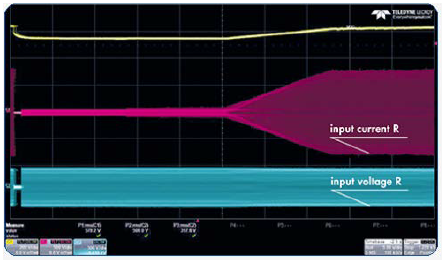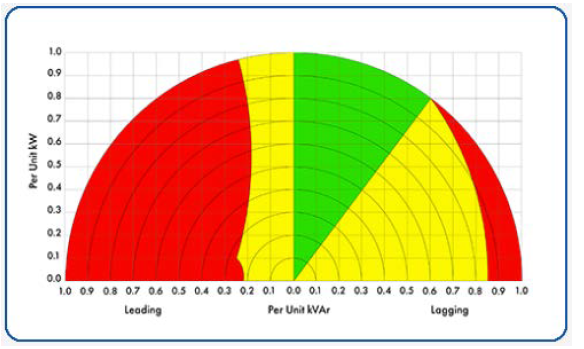UPS and generators should be best friends, smoothly cooperating to improve site’s resiliency. Often this might not be the case, due to mutual misunderstandings and lack of information. This article is a comprehensive guide and essential knowledge base about UPS input performance and its impact on generators’ operation.
In real operation, whenever a mains failure occurs, the supply is switched between incoming mains and a diesel generator set, or genset. The changeover is break-before-make, and it is usually accomplished within a few seconds. The downstream UPS system switches to battery power during the whole exchange, while its input converter, or rectifier, is off due to lack of input power. When the supply is established by the diesel generator, the rectifier performs a start-up, and the UPS operation is restored to normal double conversion. During this crucial phase it is of utmost importance that UPS and genset run like clockwork, to prevent the changeover from being jeopardized by poor interaction.
From the genset’s point of view a UPS system is a load, drawing both active and reactive power, depending on the UPS mode of operation. Up to date UPS running in VFI double conversion draw 99% “clean” real power, that is, a modern UPS is pretty much seen as a linear resistive load by the upstream supply. This simplifies a lot the design and performance of the electrical system.
In bypass operation the load is fed through the UPS bypass line by the upstream supply, which cannot thus benefit from the UPS filtering action. In this condition a genset would directly interface with the load power factor, harmonic distortion and load steps.
At light load, typically below 10% of the rated nominal power, or at no load, a UPS exhibits a predominantly capacitive input power factor and a slightly higher harmonic distortion rejection in percentage of the total absorbed power. Furthermore, the rectifier start-up transient is a load step for the upstream supply.
Although the above conditions do not impact at all the “infinite” mains power, as far as a generator set is concerned, such cases must be carefully evaluated.
As a rule of thumb, a genset continuous power rating should not be less than 1.5 times the
UPS nominal power. The oversizing factor accounts for UPS efficiency, typically 96%, UPS power factor, typically 0.99, input harmonic distortion, typically 3% and adds up a power safety margin to prevent load steps from triggering a non-stable response in the genset’s output voltage. As mentioned above, though, other parameters should be considered to ensure proper operation during transient or no-load operation.
Modern UPS do not exhibit any inrush power surge at start-ups. They gradually ramp-up to the required output power according to an adjustable “walk-in” time. This is the so called “soft-start” feature, which can also comprise a delayed start-up according to an adjustable “hold-off” time. Setting a hold-off time is useful when more UPS units are starting in parallel, so that the total UPS load is applied in gradual steps to the genset.
On the other hand, walk-in time relates to how steep the soft-start ramp will be. The shorter the setting, the steeper the ramp. It is important to note, that during the combined hold-off and walk-in time, the rectifier is not fully powered to supply the load, thus the storage batteries might still be partially discharging.

Selain itu, penghambatan pengisian baterai mungkin dilakukan untuk membantu genset dalam peningkatan beban secara bertahap. Di antara faktor-faktor lain, pergantian tanpa masalah bermuara pada pengelolaan otonomi akhir baterai dan pengaturan soft start UPS dengan benar. Yang terakhir ini terkait erat dengan kinerja keluaran genset tertentu.
Terlalu banyak CAP akan menghentikan Anda
Kapasitor input yang digunakan untuk tujuan penyaringan menyebabkan daya semu murni mengalir antara suplai dan UPS. Kekuatan seperti itu disebut sebagai kekuatan terkemuka atau kapasitif. Genset dapat mengelola daya utama murni dalam jumlah terbatas, karena mengganggu sirkuit eksitasi di generator AC, yang menyebabkan osilasi tegangan dan mematikan genset. Bagan area pengoperasian yang aman menunjukkan rentang faktor daya beban genset yang diizinkan untuk operasi yang stabil dan batas daya terdepan murni biasanya 20% dari peringkat nominal genset.

Area pengoperasian generator diesel yang aman. Operasi normal ditampilkan dalam warna hijau. Di area kuning operasi masih memungkinkan, untuk sementara. Operasi di area merah tidak diperbolehkan. Selama pengaktifan UPS, generator harus memasok daya utama murni dan titik kerjanya tepat di sumbu horizontal kiri. Batas daya terdepan murni maksimum biasanya 0,2 dari daya pengenal genset.
Sistem UPS yang dimulai ulang setelah kegagalan listrik menunjukkan daya kapasitif input murni. Meskipun kontribusinya kecil jika dibandingkan dengan peringkat nominal UPS, saat ini filter input tidak seimbang dengan daya nyata. Anda harus menunggu sampai pengaktifan penyearah selesai. Masalah ini diperbesar ketika rangkaian UPS paralel harus disuplai oleh rangkaian genset paralel. Karena start-up berurutan yang melekat pada generator, yang pertama masuk memberi makan seluruh daya kapasitif dari string UPS. Ini mungkin melebihi kemampuan genset, sehingga menghalangi pergantian yang sukses.
Beberapa teknik dapat dilakukan untuk mengurangi masalah ini, antara lain dengan memasang bank resistor sebagai kompensasi. UPS yang canggih telah mengurangi jumlah daya kapasitif masukannya, dengan menerapkan teknologi penyaringan elektronik penyearah. Mereka juga dapat menawarkan manajemen daya kapasitif input adaptif, untuk membantu merancang infrastruktur listrik yang lebih tangguh.
Tag :
Kategori
terkini postingan
Pindai ke wechat:everexceed
